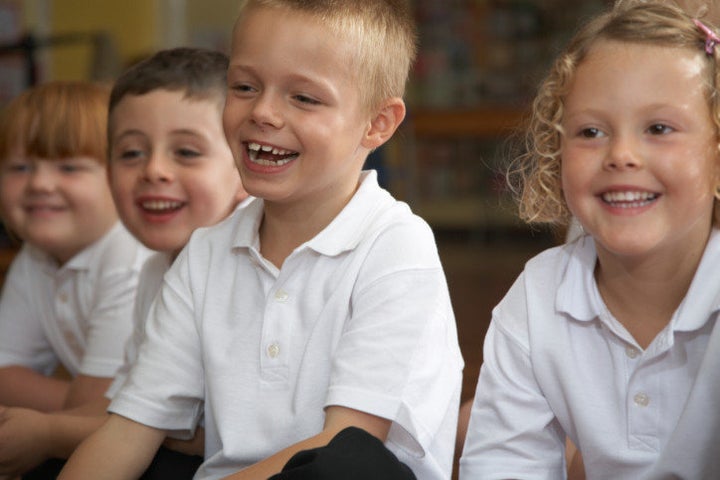
Sit back. Assume a comfortable position. Relax your shoulders, relax your jaw. Listen to the world around you.
Notice your breathing -- how your belly moves up and down. Let your belly be soft and relaxed. Slow your breathing. Take a deep breath. Take another deep breath. And another. Notice how your body and mind has been calmed. Smile.
You have now done the "Core Practice" of the MindUP curriculum, the foundation for changing your brain and thus changing your capacity to focus, attend, learn and succeed in whatever task lies ahead. For kids it is a proven method of improving classroom learning, behavior and human kindness, with applications that can extend to their everyday worlds.
When we look past the customary (narrow) focus of test scores in math and English there are a set of basic mental competencies, built through what is termed social and emotional learning (SEL), which youth will need in order to succeed in their lives. These are self-awareness, self-management, social awareness, relationship skills and responsible decision making. But try to gain these critical skills with a mind that is stressed and a brain that is geared up for fight or flight (our normal response to stress). Cognitive neuroscientists have demonstrated that for the brain to focus, think and decide clearly (in the pre-frontal cortex) and for memory and learning to be encoded effectively (through the hippocampus), the brain can't be pirated away by fear, danger and anxiety (by the amygdala). Kids can actually learn to quiet their brains so they can do the work of school and social and emotional development -- and teachers can learn how to teach this to kids.
That is what Goldie Hawn concluded in 2005 when she founded the Hawn Foundation -- dedicated to social and emotional learning. She called the brain-based method for learning and living MindUP. Her conviction grew out of the strong science base for SEL that has demonstrated that SEL improves academic achievement, as measured by standardized tests and grades as well as conduct problems -- including disruptive classroom behaviors, aggression, bullying, school suspensions and delinquent acts. Studies have shown, as well, reductions in emotional distress evidenced in youth through depression, anxiety and stress. Several of these SEL programs have demonstrated decreased alcohol and drug use. School attendance has improved and kids liked school more in programs using SEL! One study demonstrated the lasting effects of SEL on educational and economic success -- 15 years later.
Earlier research has demonstrated that while SEL improved academic performance, enhanced academic programming did not improve student social behaviors. There also is evidence that academic achievement in the eighth grade can be better predicted by social competencies than by academic achievement in the third grade. What do you want for your child?
To translate the science of brain-based learning into practice, the Hawn Foundation turned to Scholastic, one of the oldest publishers of educational materials in this country. Their joint effort has produced a guided curriculum for teachers implementing MindUP. Fifteen lessons are simply and artfully depicted for three age groups (grades K-2, 3-5 and 6-8). The MindUp curriculum is not a replacement to the school's usual reading, writing and arithmetic (and other subjects like social studies and science); it is interwoven into the students' lessons. That gives it a real chance for adoption since adding to or changing fundamental curricula in a school district, system or throughout this country seems as implausible as putting an astronaut on Pluto (whether or not either is a good idea are different matters). But there must be a commitment in the classroom to 10 minutes, three times a day, for the "Core Practice" to set the stage at the beginning of the day, at the end of the day, and during a transition like lunch or for older students when going from one classroom to another. The Scholastic curriculum was released in March of 2011, so there a roadmap is now available for teachers to use in their classrooms.
Don't make the mistake of equating MindUP with some "new age" hocus-pocus that feel-gooders want to inflict upon our children. Over 1,000 schools are using MindUP and showing improvements in test scores and grades as well as reductions in disruptive classroom behaviors. In fact, based on what neuroscientists have learned, the parts of the brain that are the basis of confidence and compassion can also be developed. The last three lessons in the curriculum are about expressing gratitude, performing acts of kindness and taking mindful action in the world. Each of these final lessons and interventions, true to MindUP's fidelity to science, are based on influencing the brain's reward and motivational systems, enhancing emotional intelligence, and because kindness is neurologically contagious.
What will be, with all due credit to Malcolm Gladwell, the "tipping point" for classroom social and emotional learning? How will this effective, low burden, very low cost technique (estimates are $5-7/child/year) that can be brought to great scale go from niche use to standard in every classroom from K through 8? Legislation in New York State now requires the NY State Education Department to develop guidelines for voluntary implementation of SEL by school districts. It's a remarkable step, but going from science to practice, even legislated science to practice, unfortunately does not have a distinguished history. In medicine, for example, closing the science to practice "gap" can take as long as fifteen (15!) years.
How to go from what we know to what we do will be the challenge ahead for MindUP and Goldie Hawn as they try to change the landscape of childhood learning.
* * * * *
References and resources:
Schonert-Reichl, KA and Lawlor, MS (2010): The effects of a mindfulness-based educational program on pre- and early adolescents' wellbeing and social-emotional competence. Mindfulness, 137-151.
Joseph A. Durlak, JA and Weissbeg, RP (2011):Promoting Social and Emotional Development is an Essential Part of Students' Education, Human Development, 1-3.
CASEL: Collaborative for Academic, Social and Emotional Learning. www.casel.org
Willis, J (2008): How your child learns best: brain friendly strategies you can use to ignite your child's learning and increase school success, Sourcebooks.
Seigel, D (2007): The mindful brain: reflection and attunement in the cultivation of wellbeing. Norton.
Schonert-Reichl, KA, Oberle, E, and associates (2011): Accelerating Cognitive and social emotional development in elementary school classrooms: benefits of a simple to administer program - submitted for publication.
Hawkins, JD, Kosterman, R and associates (2008): Effects of Social Development Intervention in Childhood 15 Years Later, Archives of Pediatric- Adolescent Medicine;16,1133-1141.
Zins, J, Weissberg, R, and associates (2004): Building academic success on social emotional learning: what does the research say? Teacher's College Press.
* * * * *
The opinions expressed herein are solely my own as a psychiatrist and public health advocate.
Dr. Sederer receives no support from any pharmaceutical or device company.
Visit Dr. Sederer's website at for questions you want answered, reviews and stories.
www.askdrlloyd.com
